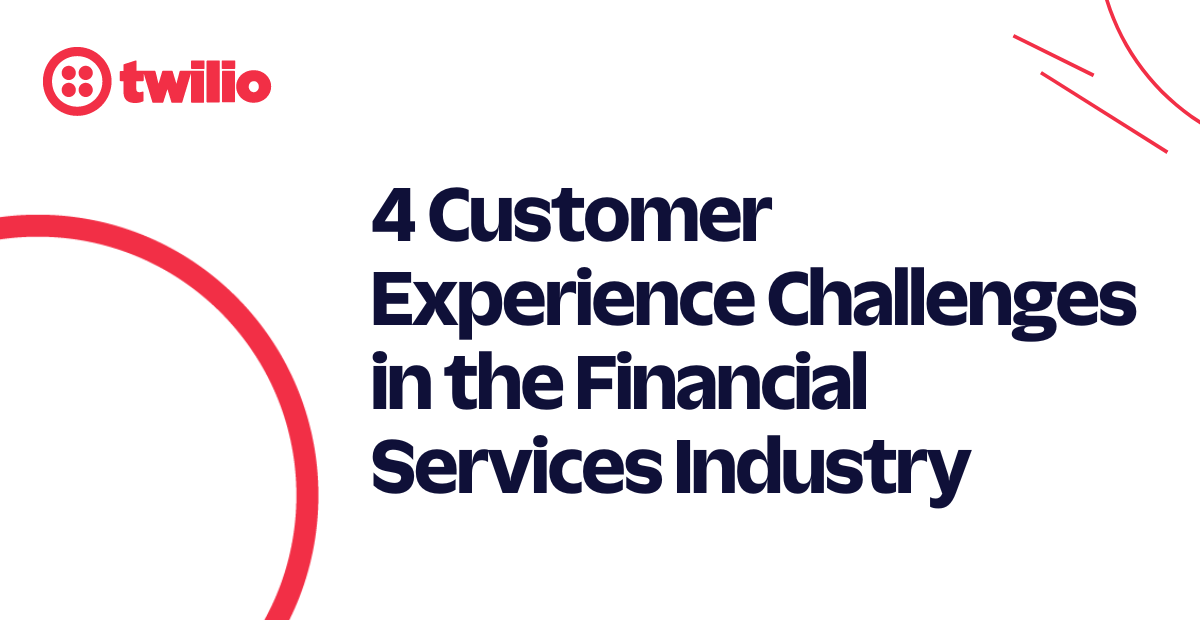4 Customer Experience Challenges in the Financial Services Industry
Time to read:
This post is part of Twilio’s archive and may contain outdated information. We’re always building something new, so be sure to check out our latest posts for the most up-to-date insights.

Like many industries today, financial institutions face new challenges due to rapidly changing technology, economic conditions, and customer expectations. But these challenges also present opportunities for the financial services industry to adapt and improve the customer experience.
Customer experience management is vital in financial services because it can impact a customer's decision to keep doing business with you. Additionally, creating a positive customer experience can help financial institutions build and maintain trust, which is crucial in this industry. So businesses must prepare to meet emerging challenges with agility.
Let’s look at 4 financial services customer experience challenges and tips on how to turn these into opportunities.
1. Keeping up with emerging channels
Banks and financial institutions that have been around for decades typically rely on legacy systems (such as call center platforms and customer databases) that are difficult to update. And these outdated systems make it challenging for businesses to add new communication channels and meet customers’ desire for more digital experiences.
However, 60% of businesses admit that an investment in digital customer engagement helps them meet changing customer needs, so keeping up with emerging digital channels is a must.
As you add new channels to your communication stack, do so strategically to avoid a disconnected multichannel approach with siloed channels. This can create inconsistent customer experiences that erode trust—51% of customers report frustration with inconsistent digital interactions.
Luckily, implementing a strategic omnichannel approach doesn’t have to be a difficult rip-and-replace process that takes months to implement. Thanks to cloud-based contact center solutions, businesses can add new channels that integrate with existing platforms and are flexible enough to scale and adapt as your needs change.
2. Blending in-person and digital experiences
Customers want to do some of their banking digitally—particularly day-to-day tasks like making deposits—but still want the human element with complex interactions.
In fact, over two thirds of consumers across all generations value having a physical bank branch in their neighborhood to solve complicated problems in person. The challenge is integrating in-person and digital interactions to create a holistic experience that helps build relationships with customers.
For example, say a customer visits a branch to open a savings account and talks to an employee about their financial goal to save for a down payment for a house. A few weeks later, the customer contacts the bank via live chat with follow-up questions about high-yield savings interest rates. If the agent doesn’t have the context of the in-person conversation, they’ll ask the customer repetitive questions, resulting in a frustrating customer experience.
This is another scenario where it’s valuable to equip employees (including those who meet customers face-to-face) with the right tools, such as the omnichannel contact center solutions we discussed above. This can help ensure that every employee has the context needed to support the customer and create a consistent, positive experience on every channel.
3. Overcoming data silos
To achieve the consistent experiences we just discussed, businesses need customer data to flow between platforms and channels seamlessly. But if you’ve added new communication channels over the years without connecting them, it can be challenging to personalize customer experiences.
Personalization is a must-have for businesses—66% of consumers say they’ll stop using a brand if it doesn’t provide personalized experiences. But there’s a gap between businesses’ and customers’ perception of personalization: 46% of brands claim to do an excellent job of providing personalization, yet only 15% of consumers would agree.
So how do you close this gap and provide true personalization? Consider adopting a customer data platform (CDP) that allows you to create complete customer profiles unifying the data from different sources. A CDP can give you a full view of the customer’s journey and how they interact with your business on different channels, enabling you to tailor your communications to the customer’s preferences and behaviors.
4. Protecting customer data
Customers trust banks with some of their most sensitive data. In fact, the finance industry is the most trusted sector, with 56% of consumers revealing they trust financial institutions with their data. However, a cybersecurity breach that compromises customer data can quickly dissolve that trust.
Financial institutions have to balance security and creating a positive customer experience—42% of business leaders say this is the biggest challenge of 2023, followed by 40% who say protecting customer data is the biggest challenge.
The good news is that taking measures to protect customer data can generate trust and improve the customer experience. Financial institutions can achieve this by implementing authentication tools that help streamline customers’ experience while keeping their data secure.
Build trust and improve the customer experience with Twilio
While the financial services customer experience faces new challenges, these aren't insurmountable but rather a chance to learn about your customers’ preferences and how you can better serve them.
Agile tools like Twilio Flex enable you to update your contact center and add communication channels that work with your existing systems. Discover how to create a contact center that fits the way you interact with customers.
Related Posts
Related Resources
Twilio Docs
From APIs to SDKs to sample apps
API reference documentation, SDKs, helper libraries, quickstarts, and tutorials for your language and platform.
Resource Center
The latest ebooks, industry reports, and webinars
Learn from customer engagement experts to improve your own communication.
Ahoy
Twilio's developer community hub
Best practices, code samples, and inspiration to build communications and digital engagement experiences.


